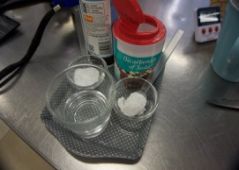Raising agents: chemical

Why do some recipes use chemical raising agents and how do they work?
What are chemical raising agents?
A common chemical raising agent used in food is baking powder, which contains two active ingredients, bicarbonate of soda (sodium bicarbonate - something called an alkali) and cream of tartar (potassium hydrogen tartrate - something called an acid).
Other chemical raising agents include self-raising flour and bicarbonate of soda. Self-raising flour has baking powder added to it already. Bicarbonate of soda can be used if the other ingredients contain an acid, such as buttermilk, lemon juice or vinegar. Be careful not to use too much bicarbonate of soda, as foods can end up tasting soapy.
How do they work?
When the molecules of bicarbonate of soda and cream of tartar come into contact in water, the alkali and acid begin to react together producing new molecules. One of which is the gas carbon dioxide.
Gases tend to take up much more space than liquid or solid things such as water or ice, so when the gas is formed by the reaction of the baking powder in the water, little gas bubbles create pockets in the baking mixture, making foods like cakes and muffins light and fluffy.
Heating up a mixture containing baking powder speeds up the chemical reaction, making the carbon dioxide gas form more quickly.
It is best to add baking powder to ingredients last, as it starts to react as soon as it comes into contact with water.
Explore:
- Completely submerge a flask in a sink or bowl of water, and turn upside down
- Get a test tube ready, which is connected to a flexible hose using an airtight bung
- Add the ingredients as set out below, insert the bung, and place the hose beneath the flask to collect the gas as it is produced over 2 mins.
- Repeat for each set of ingredients, 1-4 (below)
- You should see different volumes of gas collected in the flask.
- Bicarbonate of soda (1g) and water (5ml) (tap temperature)
- Baking powder (1g) and water (5ml) (tap temperature)
- Baking powder (1g) and water (5ml) (heated to 50C temperature)
- Bicarbonate of soda (1g), vinegar (2.5ml) and water (2.5ml) (tap temperature)
More information
AQA video: Investigating how raising agents work
OCR topic exploration pack: teacher instructions: Raising agents
BNF factsheet: Aerate


